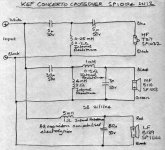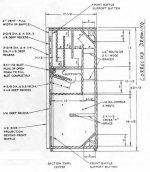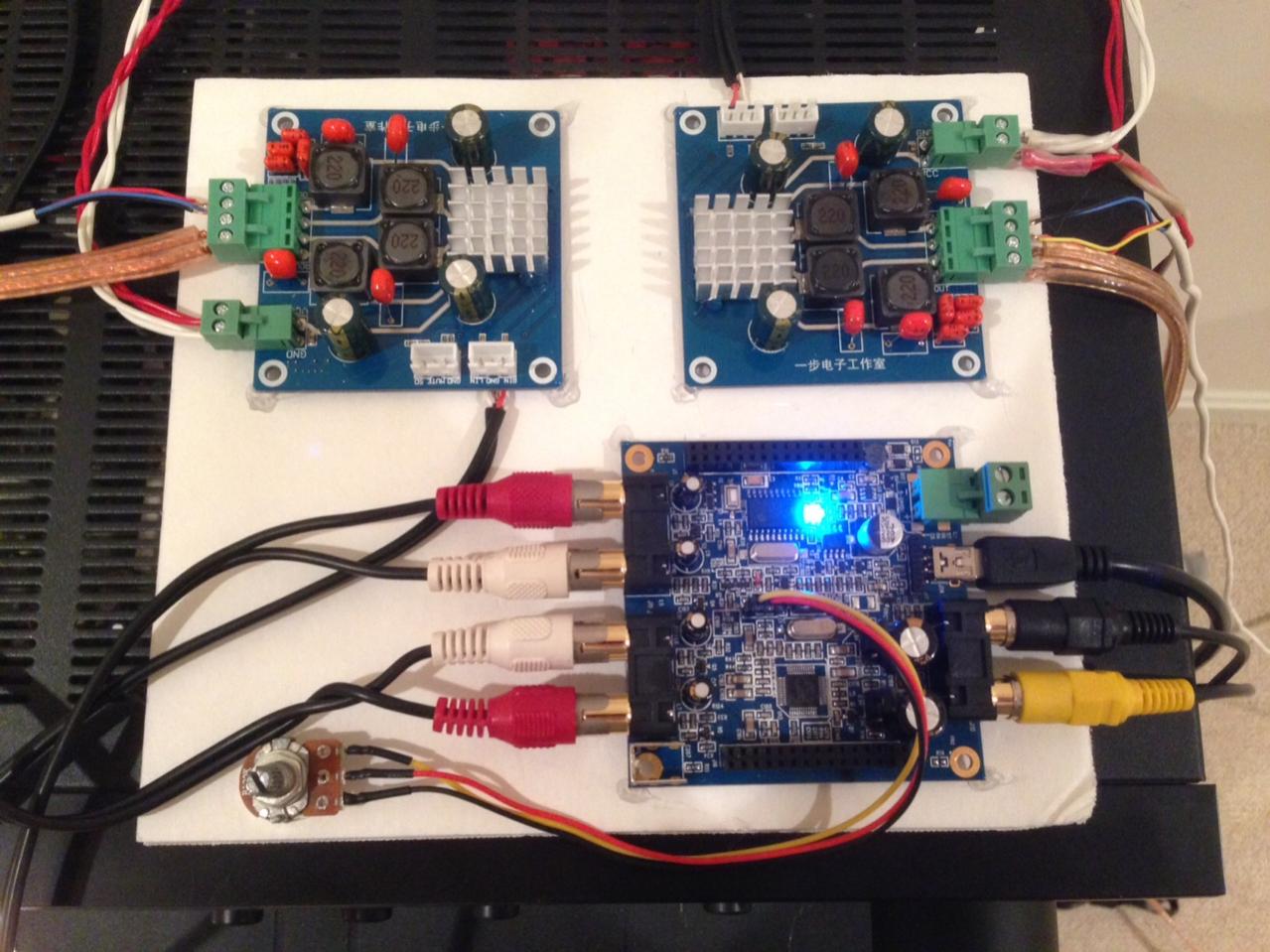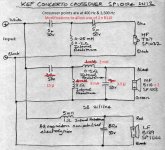To be clear, an active speaker has the crossover before the power amps, each driver has it's own amp. In studio use (and some hifi, such as Meridian) everything tends to be built in the cabinet and the whole thing is designed as a system. A few hifi companies keep the power amps outside the cabinet, such as Naim.
As Dave says, when the crossover is before the power amps it can be passive (no active components such as op-amps) or powered. Passive is much less common and has similar drawbacks to using a passive preamp (unpredictable impedance matching), so it requires more care in matching. An active crossover can have steeper slopes and more flexibility. As anything you hear via your speakers has already passed through many active stages, adding one more won't harm anything.
As Dave says, when the crossover is before the power amps it can be passive (no active components such as op-amps) or powered. Passive is much less common and has similar drawbacks to using a passive preamp (unpredictable impedance matching), so it requires more care in matching. An active crossover can have steeper slopes and more flexibility. As anything you hear via your speakers has already passed through many active stages, adding one more won't harm anything.
if the manufacturer is being honest, then the two sets of terminals will feed into different circuits.Do both pairs of terminals end up feeding the same single passive crossover or are there actually two passive discrete passive crossovers inside the box, one for the HF driver and another for the LF driver? I am just curious, I do suspect that it is pure marketing nonsense since it seems commonplace, even on budget (e.g. Richer Sounds) speakers where I doubt they would ever actually be driven by two amplifiers.
One circuit will be a filter that passes the signal to a lower frequency driver and attenuates the higher frequencies.
The other circuit will be a filter that passes the signal to a higher frequency driver and attenuates the lower frequencies.
This is easy to test.
Remove the shorting links.
Apply an audio signal from the speaker cable to ONE PAIR of terminals. You will hear one range of frequencies.
Now move the speaker cable to the OTHER PAIR of terminals. You will hear the other range of frequencies.
You can use one amplifier and one two core cable to feed the speaker with the shorting links installed.
Or
Remove the shorting links and use one amplifier and two cables to feed the speakers.
Or
Remove the shorting links and use two amplifiers and two cables to feed the speakers.
I have used this last option a lot.
I have modified some 2way speakers that came with ONE pair of terminals to become biwireable.
Yes.an active speaker has the crossover before the power amps, each driver has it's own amp.
No. The amplifiers do not need to be inside the speaker box.Active speakers are those with amp(s) built-in.
Yes.They can have active or passive XOs..........
T
As Dave says, when the crossover is before the power amps it can be passive (no active components such as op-amps) or powered.
No dave says that he has seen speakers called active with one amp driving a passive XO the distinction being that the amp is built into the box.
I have seen these discussions go on & on and that there are no clear definitions.
dave
OK, I think the more common term for a speaker that has one amplifier built into the box with a passive crossover after the amp, is a powered speaker.
Agree that the definition gets a little hazy, not helped when the hi-fi companies unleash their marketing departments to confuse the issue.
Active powered-crossover speaker gets a little cumbersome.
Agree that the definition gets a little hazy, not helped when the hi-fi companies unleash their marketing departments to confuse the issue.
Active powered-crossover speaker gets a little cumbersome.
I am revising this thread because I inadvertantly hijacked someone else's thread with much the same question and started to get some interesting responses:
I have four probably very dumb questions:
 -
-

<snip>
On a different(ish) front, I now have 4 x Kef B139, 4 x Kef B110, 4 x Kef T27 and 2 x Coles 4001G, all of approximately the same age (long story about my accidentally acquiring a 2nd KefKit 3). Ignoring the fact that these are about forty years old, how practical would it be to build a speaker based on the Sunflower Open Baffle design but using 4 x B110 and 2 x T27 as MTM and 2 x B139 as woofers? Or even 4 x B139! Would it be possible to redesign the crossovers to accommodate these drivers?
<snip>
The conversion from WMT to WMMT is actually trivial, surv1v0r.
You take an acceptable crossover, which is the KEF Concerto IIRC here, and wire the mids in series. You then adjust the values of the mid filter to double inductance and resistance, and halve capacitance.
It all works out.
I can't explain the very standard mid crossover beyond saying the first two elements block the bass below 500Hz, and the second two rolloff the top end around 3.5kHz. Hopefully you can then align phase and level with the right design choices.
You can sim with similar sorts of drivers and get some idea what is going on: Downloads
But, you will need to make allowance for different drivers at the design stage. Hopefully KEF have got it near enough right. I am not sure tweeter phase is right though. I get something different. If it's a BW3, it might not matter really.
I would be interested in pursuing this further if anyone is willing to contribute . . . please? Please note, I am starting from Ground Zero in terms of understanding the design and modification of passive crossovers so do forgive my naivety. I have tried to make a start by studying a .PDF entitled "Crossover de-mystified" and as suggested by System7, I have downloaded BoxSim and will try to get to grips with that.Hi surv1v0r,
Yep, the midrange will have a bandpass filter. The 30uF cap and 4mH inductor form a second order highpass filter, which then feeds into the 1mH inductor and 7uF cap, which is a 2nd order low-pass. Between them, you get a 12dB/octave electrical rolloff at each end of the midrange's operating band.
Chris
I have four probably very dumb questions:
- The three Kef drivers have a nominal impedance of 8 Ohms. However, when measured with a Multimeter they never seem to read 8 Ohms. Should I use the "nominal" or "actual figure in BoxSim?
- The three drivers are (effectively) wired in parallel and yet the effective impedance of the Kef Concerto is 8 Ohms - how so? I realise that the impedance will vary with frequency - is that the explanation?
- How would I go about adjusting the values of the mid filter in the Kef DN12 crossover to double inductance and resistance, and halve capacitance (e.g. to allow the use of 2 x 8 Ohm B110s)?
- When designing a crossover, are you simply looking at filtering the signal to each driver, independent of cabinet issues. To explain why I ask this, consider the B J Webb R50 Transmission Line Monitor where the both the B139 and the B110 seem to operate in transmission lines whereas in the case of the Kef Concerto, the B139 operates in a bass reflex cabinet and the B110 operates in a colsed box (tube actually).
 -
-

Too many questions to answer them all! 
Nominal impedance of 8 ohms usually means a DC resistance of around 6 ohms on a driver.
The KEF Concerto impedance is around 5 ohms overall. This is common with 3-ways.
The midrange filter conversion ends up as 15uF, 8mH, 2mH and 3.5uF with two B110 in series.
Import some of these into Boxsim and play with them:
boxsim-db.de | Boxsim Projektdatenbank
Import a 4 driver speaker to look at a WMMT, since it can be quickly redesigned. You can mark components in red in Boxsim and get it to optimise the design. It usually does quite well, especially if you give it some attenuating resistors to adjust for driver level.
You are usually targeting a driver response like this with a three way:
http://www.diyaudio.com/forums/multi-way/258017-troels-gravesen-time-aligned-3-way-published.html
The box and baffle affects the slope and smoothness of the driver's low end response. Usually called bafflestep. A transmission line is a glorified damped reflex.
Nominal impedance of 8 ohms usually means a DC resistance of around 6 ohms on a driver.
The KEF Concerto impedance is around 5 ohms overall. This is common with 3-ways.
The midrange filter conversion ends up as 15uF, 8mH, 2mH and 3.5uF with two B110 in series.
Import some of these into Boxsim and play with them:
boxsim-db.de | Boxsim Projektdatenbank
Import a 4 driver speaker to look at a WMMT, since it can be quickly redesigned. You can mark components in red in Boxsim and get it to optimise the design. It usually does quite well, especially if you give it some attenuating resistors to adjust for driver level.
You are usually targeting a driver response like this with a three way:
An externally hosted image should be here but it was not working when we last tested it.
http://www.diyaudio.com/forums/multi-way/258017-troels-gravesen-time-aligned-3-way-published.html
The box and baffle affects the slope and smoothness of the driver's low end response. Usually called bafflestep. A transmission line is a glorified damped reflex.
Thanks for that System7.
So, the mid-range DCR moves from 6 Ω to 12 Ω and to cater for this, you halve the value of the capacitors and double the value of the inductors?
View attachment 443060
Yup, that's it. You can double the coil resistance too, to be precise. 3.3uF should be near enough.
If you do the sums, each driver gets half the voltage. And based on VxV/R, it means they each put out 1/4 the power. So you half the acoustic power in the midrange. But because there are two drivers, the SPL gains 3dB. The mystery power loss and impedance rise is compensated by the cylindrical nature of the dispersion in the far field.
This sort of WMTM speaker has tremendous midrange presence IMO. Like the Wharfedale E70:
An externally hosted image should be here but it was not working when we last tested it.
Which is why MTM is popular in PA systems.
This is why we call it DIYaudio...Are there any issues in terms of the positioning of / relationship between the mid-range units and the tweeter?
There are many solutions, each with different strengths and weaknesses.
The worst aspect of D'Appolito is the differing falloff of power with driver distance. The dual mids in an MTM fall off as inverse distance, the single tweeter falls off as inverse square.
What that means is that there is an optimum distance for balanced listening. MTTM avoids that theoretical difficulty. For all that, D'Appolito sounds very good IMO.
I wouldn't worry too much about vertical or staggered alignment. This mainly affects lobing off-axis. Which is the phenomena whereby the sound balance at crossover changes as you listen at above and below or sideways of a speaker.
An externally hosted image should be here but it was not working when we last tested it.
The Wharfedale E70 (which used efficient paper drivers, as opposed to the more polite bextrene drivers you have) was a great speaker IMO. But for sure, the tweeter level is going to be harsh if you get too close.
Last edited:
Forgive my ignorance here, but would a 3dB SPL gain in the mid-range be noticeable or is it so minimal as to make no identifiable difference?<snip>
Because there are two drivers, the SPL gains 3dB.
<snip>
Specifically, would this change make the mid-range more prominent?
I think I said the overall level is unaffected in the series MTM conversion. But the power response with distance and direction changes.
A 3db error in sound level (SPL) on its own would be horrible. What arrays of drivers do, is project better. You may have noticed how unpleasantly loud 2 way PA speakers sound close up in pubs and nightclubs. Arrays ease this difficulty.
I think people lose too much sleep over combing. It doesn't sound bad IMO, and becomes less of a problem with distance.
The reason you offset drivers to the side of the box is to ease some diffraction problems. You can get some awkward dips and peaks in frequency response with symettrical layouts where the distance to the edge of the box is a quarter or a half wavelength.
Morgan Jones explains a lot of this stuff here: http://www.diyaudio.com/forums/diyaudio-com-articles/158899-arpeggio-loudspeaker.html
Somebody thought I was exaggerating in saying that article is a masterclass in design. I stick with that opinion.
A 3db error in sound level (SPL) on its own would be horrible. What arrays of drivers do, is project better. You may have noticed how unpleasantly loud 2 way PA speakers sound close up in pubs and nightclubs. Arrays ease this difficulty.
I think people lose too much sleep over combing. It doesn't sound bad IMO, and becomes less of a problem with distance.
The reason you offset drivers to the side of the box is to ease some diffraction problems. You can get some awkward dips and peaks in frequency response with symettrical layouts where the distance to the edge of the box is a quarter or a half wavelength.
Morgan Jones explains a lot of this stuff here: http://www.diyaudio.com/forums/diyaudio-com-articles/158899-arpeggio-loudspeaker.html
Somebody thought I was exaggerating in saying that article is a masterclass in design. I stick with that opinion.
Last edited:
One thing I always wondered about using an active crossover feeding separate power amps for each driver: I understand that the tweeter amp can be much lower POWER than the bass amp because there is less energy is the music spectrum at higher frequencies, but shouldn't both amps have the same VOLTAGE GAIN?
It's not necessary, especially if there is an easy method to adjust the gain structure of the various elements. I don't think I've built an active system with amps of all the same voltage gain in years. My current mains and surrounds (all active tri-amped) each use a variety of amp brands and/or models.but shouldn't both amps have the same VOLTAGE GAIN?
One thing I always wondered about using an active crossover feeding separate power amps for each driver: I understand that the tweeter amp can be much lower POWER than the bass amp because there is less energy is the music spectrum at higher frequencies, but shouldn't both amps have the same VOLTAGE GAIN?
It certainly eases matching if amps are identical, but even completely different amps can be used for active loudspeakers, so long as the results are tuned based on measurement of the active circuit, rather than theoretical filter/driver performance in isolation- amps may have different latency (generally not too much of an issue) or phase performance, and those are a bigger concern than voltage gain- gain can be adjusted within the line-level crossover.
In the words of Mr Bridger - "For why Planet10? For why?"Many manufacturers will use the term to mean passive bi-amping, where the passive XO is separated into 2 or more parts and it is possible to drive each section of the passive XO with a different amplifier.
<snip>
Just curious, but is there any benefit at all in using two amps to drive two discrete passive crossovers in a multi-way speaker?
Is it to allow the use of lower powered, perhaps cheaper amps; to facilitate tone control or is it just marketing tosh?
Even cheap (i.e. Richer Sounds) speakers often seem to claim to offer Bi-Amping.
Details on a $150 50w/ch 2x4 active miniDSP system:
http://www.diyaudio.com/forums/multi-way/210627-wilmslow-audio-prestige-platinum-38.html#post4094830

http://www.diyaudio.com/forums/multi-way/210627-wilmslow-audio-prestige-platinum-38.html#post4094830

- Status
- This old topic is closed. If you want to reopen this topic, contact a moderator using the "Report Post" button.
- Home
- Loudspeakers
- Multi-Way
- Crossover & Bi-Amping 101
